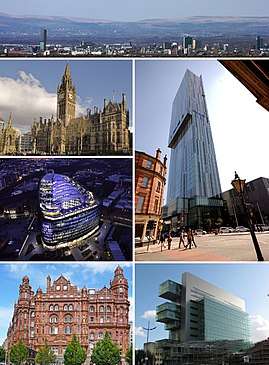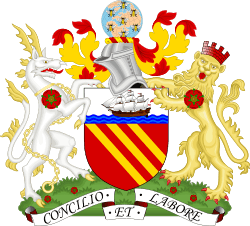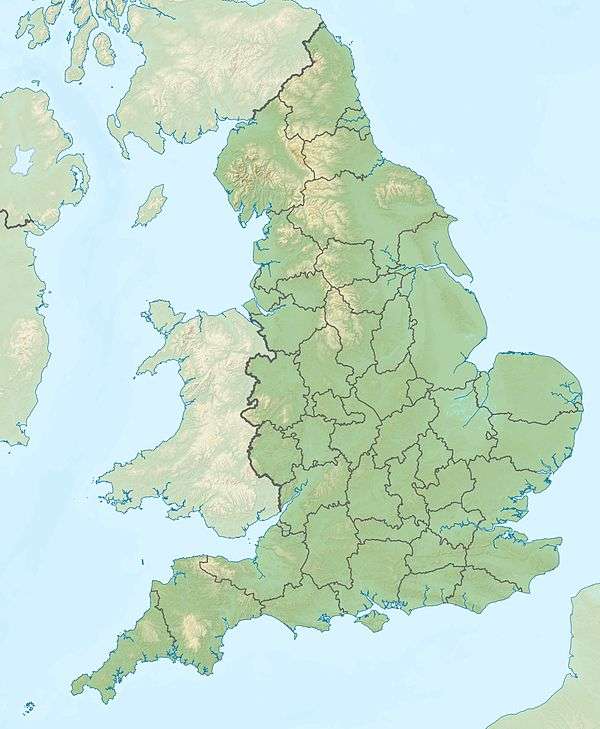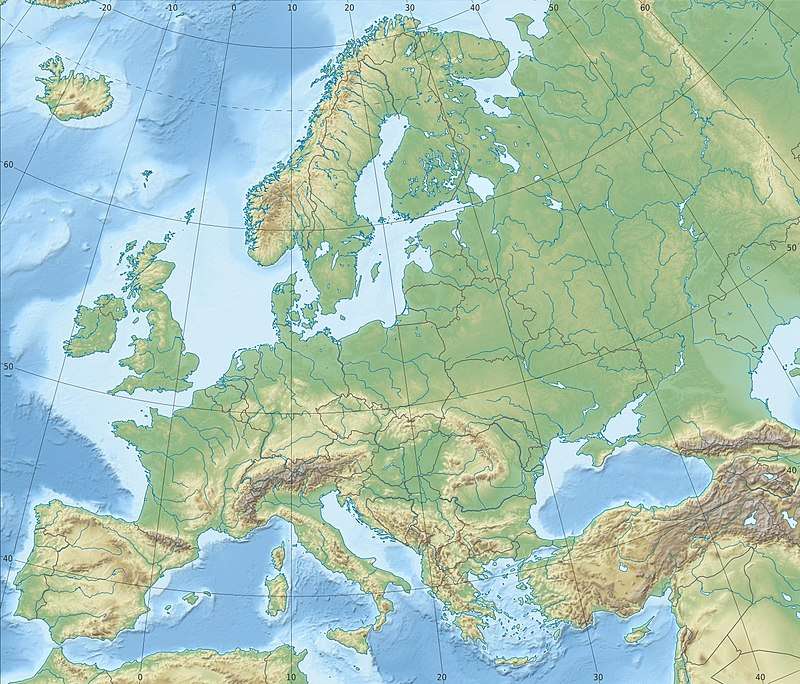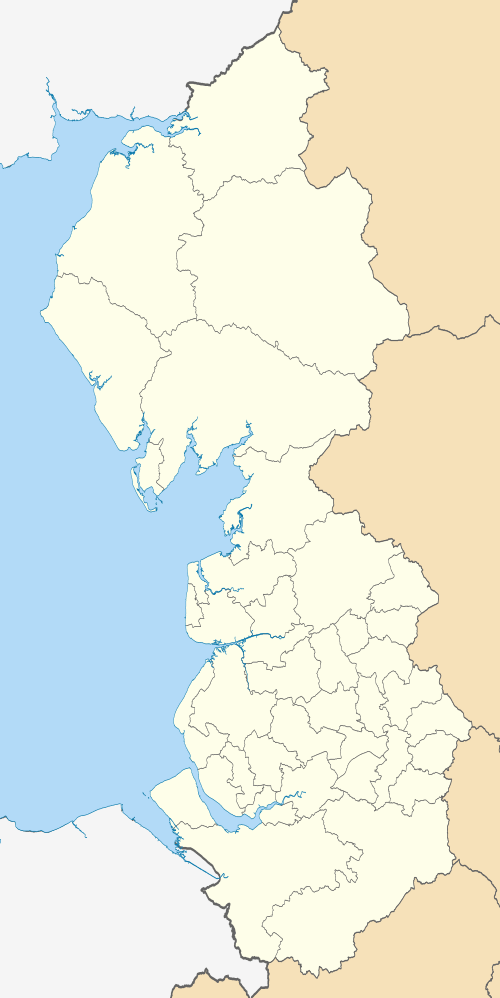Manchester
Coordinates: 53°28′46″N 2°14′43″W / 53.47944°N 2.24528°W
Manchester (/ˈmæntʃɪstər,
The recorded history of Manchester began with the civilian settlement associated with the Roman fort of Mamucium or Mancunium, which was established in about AD 79 on a sandstone bluff near the confluence of the rivers Medlock and Irwell. It was historically a part of Lancashire, although areas of Cheshire south of the River Mersey were incorporated in the 20th century.[9] Throughout the Middle Ages Manchester remained a manorial township but began to expand "at an astonishing rate" around the turn of the 19th century. Manchester's unplanned urbanisation was brought on by a boom in textile manufacture during the Industrial Revolution,[10] and resulted in it becoming the world's first industrialised city.[11]
Manchester achieved city status in 1853. The Manchester Ship Canal opened in 1894, creating the Port of Manchester and directly linking the city to the Irish Sea, 36 miles (58 km) to the west. Its fortune declined after the Second World War, owing to deindustrialisation, but the IRA bombing in 1996 led to extensive investment and regeneration.[12]
In 2014, the Globalization and World Cities Research Network ranked Manchester as a beta world city, the highest-ranked British city apart from London.[13] Manchester is the third-most visited city in the UK, after London and Edinburgh.[14] It is notable for its architecture, culture, musical exports, media links, scientific and engineering output, social impact, sports clubs and transport connections. Manchester Liverpool Road railway station was the world's first inter-city passenger railway station; scientists first split the atom, developed the stored-program computer and produced graphene in the city. Manchester hosted the 2002 Commonwealth Games.
Name
The name Manchester originates from the Latin name Mamucium or its variant Mancunium and the citizens are still referred to as Mancunians (/mænˈkjuːniən/). These are generally thought to represent a Latinisation of an original Brittonic name, either from mamm- ("breast", in reference to a "breast-like hill") or from mamma ("mother", in reference to a local river goddess). Both meanings are preserved in Insular Celtic languages, such as mam meaning "breast" in Irish and "mother" in Welsh.[15] The suffix -chester is a survival of Old English ceaster ("fort; fortified town").[16]
History
Early history
The Brigantes were the major Celtic tribe in what is now known as Northern England; they had a stronghold in the locality at a sandstone outcrop on which Manchester Cathedral now stands, opposite the banks of the River Irwell.[17] Their territory extended across the fertile lowland of what is now Salford and Stretford. Following the Roman conquest of Britain in the 1st century, General Agricola ordered the construction of a fort named Mamucium in the year 79 to ensure that Roman interests in Deva Victrix (Chester) and Eboracum (York) were protected from the Brigantes.[17] Central Manchester has been permanently settled since this time.[18] A stabilised fragment of foundations of the final version of the Roman fort is visible in Castlefield. The Roman habitation of Manchester probably ended around the 3rd century; its civilian settlement appears to have been abandoned by the mid-3rd century, although the fort may have supported a small garrison until the late 3rd or early 4th century.[19] After the Roman withdrawal and Saxon conquest, the focus of settlement shifted to the confluence of the Irwell and Irk sometime before the arrival of the Normans after 1066.[20] Much of the wider area was laid waste in the subsequent Harrying of the North.[21][22]
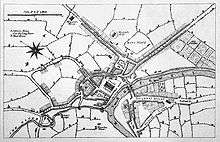

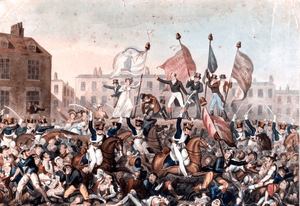
Thomas de la Warre, lord of the manor, founded and constructed a collegiate church for the parish in 1421. The church is now Manchester Cathedral; the domestic premises of the college house Chetham's School of Music and Chetham's Library.[20][23] The library, which opened in 1653 and is still open to the public today, is the oldest free public reference library in the United Kingdom.[24]
Manchester is mentioned as having a market in 1282.[25] Around the 14th century, Manchester received an influx of Flemish weavers, sometimes credited as the foundation of the region's textile industry.[26] Manchester became an important centre for the manufacture and trade of woollens and linen, and by about 1540, had expanded to become, in John Leland's words, "The fairest, best builded, quickest, and most populous town of all Lancashire."[20] The cathedral and Chetham's buildings are the only significant survivors of Leland's Manchester.[21]
During the English Civil War Manchester strongly favoured the Parliamentary interest. Although not long-lasting, Cromwell granted it the right to elect its own MP. Charles Worsley, who sat for the city for only a year, was later appointed Major General for Lancashire, Cheshire and Staffordshire during the Rule of the Major Generals. He was a diligent puritan, turning out ale houses and banning the celebration of Christmas; he died in 1656.[27]
Significant quantities of cotton began to be used after about 1600, firstly in linen/cotton fustians, but by around 1750 pure cotton fabrics were being produced and cotton had overtaken wool in importance.[20] The Irwell and Mersey were made navigable by 1736, opening a route from Manchester to the sea docks on the Mersey. The Bridgewater Canal, Britain's first wholly artificial waterway, was opened in 1761, bringing coal from mines at Worsley to central Manchester. The canal was extended to the Mersey at Runcorn by 1776. The combination of competition and improved efficiency halved the cost of coal and halved the transport cost of raw cotton.[20][23] Manchester became the dominant marketplace for textiles produced in the surrounding towns.[20] A commodities exchange, opened in 1729,[21] and numerous large warehouses, aided commerce. In 1780, Richard Arkwright began construction of Manchester's first cotton mill.[21][23] In the early 1800s, John Dalton formulated his atomic theory in Manchester.
Industrial Revolution
Manchester's history is concerned with textile manufacture during the Industrial Revolution. The great majority of cotton spinning took place in the towns of south Lancashire and north Cheshire, and Manchester was for a time the most productive centre of cotton processing,[28] and later the world's largest marketplace for cotton goods.[20][29] Manchester was dubbed "Cottonopolis" and "Warehouse City" during the Victorian era.[28] In Australia, New Zealand and South Africa, the term "manchester" is still used for household linen: sheets, pillow cases, towels, etc.[30] The industrial revolution brought about huge change in Manchester and was key to the increase in Manchester's population.
Manchester began expanding "at an astonishing rate" around the turn of the 19th century as people flocked to the city for work from Scotland, Wales, Ireland and other areas of England as part of a process of unplanned urbanisation brought on by the Industrial Revolution.[31][32][33] It developed a wide range of industries, so that by 1835 "Manchester was without challenge the first and greatest industrial city in the world."[29] Engineering firms initially made machines for the cotton trade, but diversified into general manufacture. Similarly, the chemical industry started by producing bleaches and dyes, but expanded into other areas. Commerce was supported by financial service industries such as banking and insurance.

.jpg)
Trade, and feeding the growing population, required a large transport and distribution infrastructure: the canal system was extended, and Manchester became one end of the world's first intercity passenger railway—the Liverpool and Manchester Railway. Competition between the various forms of transport kept costs down.[20] In 1878 the GPO (the forerunner of British Telecom) provided its first telephones to a firm in Manchester.[34]
The Manchester Ship Canal was built between 1888 and 1894, in some sections by canalisation of the Rivers Irwell and Mersey, running 36 miles (58 km)[35] from Salford to Eastham Locks on the tidal Mersey. This enabled oceangoing ships to sail right into the Port of Manchester. On the canal's banks, just outside the borough, the world's first industrial estate was created at Trafford Park.[20] Large quantities of machinery, including cotton processing plant, were exported around the world.
A centre of capitalism, Manchester was once the scene of bread and labour riots, as well as calls for greater political recognition by the city's working and non-titled classes. One such gathering ended with the Peterloo Massacre of 16 August 1819. The economic school of Manchester capitalism developed there, and Manchester was the centre of the Anti-Corn Law League from 1838 onward.
Manchester has a notable place in the history of Marxism and left-wing politics; being the subject of Friedrich Engels' work The Condition of the Working Class in England in 1844; Engels spent much of his life in and around Manchester,[36] and when Karl Marx visited Manchester, they met at Chetham's Library. The economics books Marx was reading at the time can be seen in the library, as can the window seat where Marx and Engels would meet.[24] The first Trades Union Congress was held in Manchester (at the Mechanics' Institute, David Street), from 2 to 6 June 1868. Manchester was an important cradle of the Labour Party and the Suffragette Movement.[37]
At that time, it seemed a place in which anything could happen—new industrial processes, new ways of thinking (the Manchester School, promoting free trade and laissez-faire), new classes or groups in society, new religious sects, and new forms of labour organisation. It attracted educated visitors from all parts of Britain and Europe. A saying capturing this sense of innovation survives today: "What Manchester does today, the rest of the world does tomorrow."[38] Manchester's golden age was perhaps the last quarter of the 19th century. Many of the great public buildings (including Manchester Town Hall) date from then. The city's cosmopolitan atmosphere contributed to a vibrant culture, which included the Hallé Orchestra. In 1889, when county councils were created in England, the municipal borough became a county borough with even greater autonomy.
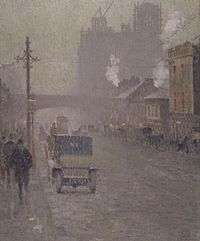
Although the Industrial Revolution brought wealth to the city, it also brought poverty and squalor to a large part of the population. Historian Simon Schama noted that "Manchester was the very best and the very worst taken to terrifying extremes, a new kind of city in the world; the chimneys of industrial suburbs greeting you with columns of smoke". An American visitor taken to Manchester's blackspots saw "wretched, defrauded, oppressed, crushed human nature, lying and bleeding fragments".[39]
The number of cotton mills in Manchester itself reached a peak of 108 in 1853.[28] Thereafter the number began to decline and Manchester was surpassed as the largest centre of cotton spinning by Bolton in the 1850s and Oldham in the 1860s.[28] However, this period of decline coincided with the rise of the city as the financial centre of the region.[28] Manchester continued to process cotton, and in 1913, 65% of the world's cotton was processed in the area.[20] The First World War interrupted access to the export markets. Cotton processing in other parts of the world increased, often on machines produced in Manchester. Manchester suffered greatly from the Great Depression and the underlying structural changes that began to supplant the old industries, including textile manufacture.
Manchester Blitz
Like most of the UK, the Manchester area was mobilised extensively during the Second World War. For example, casting and machining expertise at Beyer, Peacock and Company's locomotive works in Gorton was switched to bomb making; Dunlop's rubber works in Chorlton-on-Medlock made barrage balloons; and just outside the city in Trafford Park, engineers Metropolitan-Vickers made Avro Manchester and Avro Lancaster bombers and Ford built the Rolls-Royce Merlin engines to power them. Manchester was thus the target of bombing by the Luftwaffe, and by late 1940 air raids were taking place against non-military targets. The biggest took place during the "Christmas Blitz" on the nights of 22/23 and 24 December 1940, when an estimated 474 tonnes (467 long tons) of high explosives plus over 37,000 incendiary bombs were dropped. A large part of the historic city centre was destroyed, including 165 warehouses, 200 business premises, and 150 offices. 376 were killed and 30,000 houses were damaged.[40] Manchester Cathedral was among the buildings seriously damaged; its restoration took 20 years.[41]
Post-Second World War
Cotton processing and trading continued to fall in peacetime, and the exchange closed in 1968.[20] By 1963 the port of Manchester was the UK's third largest,[42] and employed over 3,000 men, but the canal was unable to handle the increasingly large container ships. Traffic declined, and the port closed in 1982.[43] Heavy industry suffered a downturn from the 1960s and was greatly reduced under the economic policies followed by Margaret Thatcher's government after 1979. Manchester lost 150,000 jobs in manufacturing between 1961 and 1983.[20]
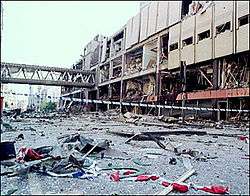
Regeneration began in the late 1980s, with initiatives such as the Metrolink, the Bridgewater Concert Hall, the Manchester Arena, and (in Salford) the rebranding of the port as Salford Quays. Two bids to host the Olympic Games were part of a process to raise the international profile of the city.[45]
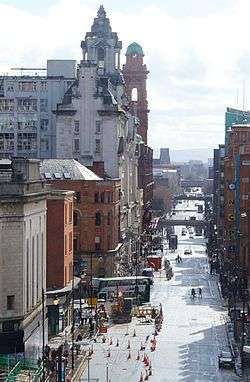
Manchester has a history of attacks attributed to Irish Republicans, including the Manchester Martyrs of 1867, arson in 1920, a series of explosions in 1939, and two bombs in 1992. On Saturday 15 June 1996, the Provisional Irish Republican Army (IRA) carried out the 1996 Manchester bombing, the detonation of a large bomb next to a department store in the city centre. The largest to be detonated on British soil, the bomb injured over 200 people, heavily damaged nearby buildings, and broke windows 1⁄2 mile (800 m) away. The cost of the immediate damage was initially estimated at £50 million, but this was quickly revised upwards.[46] The final insurance payout was over £400 million; many affected businesses never recovered from the loss of trade.[47]
Since 2000
Spurred by the investment after the 1996 bomb, and aided by the XVII Commonwealth Games, Manchester's city centre has undergone extensive regeneration.[45] New and renovated complexes such as The Printworks and the Corn Exchange have become popular shopping, eating and entertainment destinations. The Manchester Arndale is the UK's largest city centre shopping centre.[48]
Large sections of the city dating from the 1960s have been either demolished and re-developed or modernised with the use of glass and steel. Old mills have been converted into modern apartments, Hulme has undergone extensive regeneration programmes, and million-pound lofthouse apartments have since been developed. The 169-metre tall, 47-storey Beetham Tower, completed in 2006, is the tallest building in the UK outside London and when finished was the highest residential accommodation in Europe.[49] In January 2007, the independent Casino Advisory Panel awarded Manchester a licence to build the only supercasino in the UK,[50] however plans were officially abandoned in February 2008.[51]
Since around the turn of the 21st century, Manchester has been regarded by sections of the international press,[52] British public,[53] and government ministers as being the second city of the United Kingdom.[54][55] The BBC reports that redevelopment of recent years has heightened claims that Manchester is the second city of the UK.[56] Manchester and Birmingham have traditionally competed as frontrunners for this unofficial title.[56]
Governance

The City of Manchester is governed by the Manchester City Council. The Greater Manchester Combined Authority, with a directly elected mayor, has responsibilities for economic strategy and transport, amongst other areas, on a Greater Manchester-wide basis. Manchester has been a member of the English Core Cities Group since its inception in 1995.[57]
The town of Manchester was granted a charter by Thomas Grelley in 1301, but lost its borough status in a court case of 1359. Until the 19th century local government was largely in the hands of manorial courts, the last of which was dissolved in 1846.[58]
From a very early time, the township of Manchester lay within the historic or ceremonial county boundaries of Lancashire.[58] Pevsner wrote "That [neighbouring] Stretford and Salford are not administratively one with Manchester is one of the most curious anomalies of England".[26] A stroke of a Norman baron's pen is said to have divorced Manchester and Salford, though it was not Salford that became separated from Manchester, it was Manchester, with its humbler line of lords, that was separated from Salford.[59] It was this separation that resulted in Salford becoming the judicial seat of Salfordshire, which included the ancient parish of Manchester. Manchester later formed its own Poor Law Union using the name "Manchester".[58] In 1792, Commissioners—usually known as "Police Commissioners"—were established for the social improvement of Manchester. Manchester regained its borough status in 1838, and comprised the townships of Beswick, Cheetham Hill, Chorlton upon Medlock and Hulme.[58] By 1846, with increasing population and greater industrialisation, the Borough Council had taken over the powers of the "Police Commissioners". In 1853, Manchester was granted "city status" in the United Kingdom.[58]
In 1885, Bradford, Harpurhey, Rusholme and parts of Moss Side and Withington townships became part of the City of Manchester. In 1889, the city became a county borough as did many larger Lancashire towns, and therefore not governed by Lancashire County Council.[58] Between 1890 and 1933, more areas were added to the city which had been administered by Lancashire County Council, including former villages such as Burnage, Chorlton-cum-Hardy, Didsbury, Fallowfield, Levenshulme, Longsight, and Withington. In 1931, the Cheshire civil parishes of Baguley, Northenden and Northen Etchells from the south of the River Mersey were added.[58] In 1974, by way of the Local Government Act 1972, the City of Manchester became a metropolitan district of the metropolitan county of Greater Manchester.[58] That year, Ringway, the village where the Manchester Airport is located, was added to the City.
In November 2014, it was announced that Greater Manchester would receive a new directly elected Mayor. The Mayor would have fiscal control over health, transport, housing and police in the area.[60] Andy Burnham was elected as the first Mayor of Greater Manchester in 2017.
Geography
| Manchester | ||||||||||||||||||||||||||||||||||||||||||||||||||||||||||||
|---|---|---|---|---|---|---|---|---|---|---|---|---|---|---|---|---|---|---|---|---|---|---|---|---|---|---|---|---|---|---|---|---|---|---|---|---|---|---|---|---|---|---|---|---|---|---|---|---|---|---|---|---|---|---|---|---|---|---|---|---|
| Climate chart (explanation) | ||||||||||||||||||||||||||||||||||||||||||||||||||||||||||||
| ||||||||||||||||||||||||||||||||||||||||||||||||||||||||||||
| ||||||||||||||||||||||||||||||||||||||||||||||||||||||||||||
At 53°28′0″N 2°14′0″W / 53.46667°N 2.23333°W, 160 miles (260 km) northwest of London, Manchester lies in a bowl-shaped land area bordered to the north and east by the Pennines, an upland chain that runs the length of northern England, and to the south by the Cheshire Plain. Manchester is 35.0 miles (56.3 km) north-east of Liverpool and 35.0 miles (56.3 km) north-west of Sheffield, making the city the halfway point between the two. The city centre is on the east bank of the River Irwell, near its confluences with the Rivers Medlock and Irk, and is relatively low-lying, being between 35 to 42 metres (115 to 138 feet) above sea level.[61] The River Mersey flows through the south of Manchester. Much of the inner city, especially in the south, is flat, offering extensive views from many highrise buildings in the city of the foothills and moors of the Pennines, which can often be capped with snow in the winter months. Manchester's geographic features were highly influential in its early development as the world's first industrial city. These features are its climate, its proximity to a seaport at Liverpool, the availability of water power from its rivers, and its nearby coal reserves.[62]
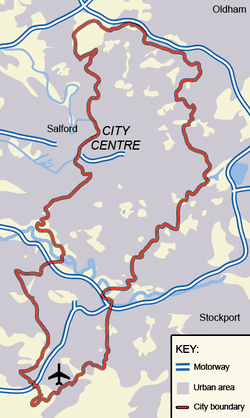
The name Manchester, though officially applied only to the metropolitan district within Greater Manchester, has been applied to other, wider divisions of land, particularly across much of the Greater Manchester county and urban area. The "Manchester City Zone", "Manchester post town" and the "Manchester Congestion Charge" are all examples of this.
For purposes of the Office for National Statistics, Manchester forms the most populous settlement within the Greater Manchester Urban Area, the United Kingdom's third-largest conurbation. There is a mixture of high-density urban and suburban locations in Manchester. The largest open space in the city, at around 260 hectares (642 acres),[63] is Heaton Park. Manchester is contiguous on all sides with several large settlements, except for a small section along its southern boundary with Cheshire. The M60 and M56 motorways pass through the south of Manchester, through Northenden and Wythenshawe respectively. Heavy rail lines enter the city from all directions, the principal destination being Manchester Piccadilly station.
Climate
Manchester experiences a temperate Oceanic climate, like much of the British Isles, with mild summers and cool winters. Summer daytime temperatures regularly top 20 Celsius, typically reaching 25 Celsius on sunny days throughout July and August in particular. In more recent years, temperatures now reach over 30 Celsius on occasions. There is regular but generally light precipitation throughout the year. The city's average annual rainfall is 806.6 millimetres (31.76 in)[64] compared to the UK average of 1,125.0 millimetres (44.29 in),[65] and its mean rain days are 140.4 per annum,[64] compared to the UK average of 154.4.[65] Manchester has a relatively high humidity level and this, along with the abundant supply of soft water, was one of the factors that led to the localisation of the textile industry in the area.[66] Snowfalls are not common in the city because of the urban warming effect but the West Pennine Moors to the northwest, South Pennines to the northeast and Peak District to the east receive more snow, which can close roads leading out of the city.[67] They include the A62 via Oldham and Standedge,[68] the A57, Snake Pass, towards Sheffield,[69] and the Pennine section of the M62.[70] The lowest temperature ever recorded in Manchester was −17.6 °C (0.3 °F) on 7th January 2010. [71]
| Climate data for Manchester (MAN), elevation: 69 m or 226 ft, 1981-2010 normals, extremes 1958-2004 | |||||||||||||
|---|---|---|---|---|---|---|---|---|---|---|---|---|---|
| Month | Jan | Feb | Mar | Apr | May | Jun | Jul | Aug | Sep | Oct | Nov | Dec | Year |
| Record high °C (°F) | 14.3 (57.7) |
16.5 (61.7) |
21.7 (71.1) |
25.1 (77.2) |
26.7 (80.1) |
31.3 (88.3) |
32.2 (90) |
33.7 (92.7) |
28.4 (83.1) |
25.6 (78.1) |
17.7 (63.9) |
15.1 (59.2) |
33.7 (92.7) |
| Mean maximum °C (°F) | 12.4 (54.3) |
12.6 (54.7) |
15.6 (60.1) |
19.1 (66.4) |
23.1 (73.6) |
25.5 (77.9) |
26.9 (80.4) |
27.0 (80.6) |
23.1 (73.6) |
18.9 (66) |
15.4 (59.7) |
13.2 (55.8) |
28.7 (83.7) |
| Average high °C (°F) | 7.3 (45.1) |
7.6 (45.7) |
10.0 (50) |
12.6 (54.7) |
16.1 (61) |
18.6 (65.5) |
20.6 (69.1) |
20.3 (68.5) |
17.6 (63.7) |
13.9 (57) |
10.0 (50) |
7.4 (45.3) |
13.5 (56.3) |
| Daily mean °C (°F) | 4.5 (40.1) |
4.6 (40.3) |
6.7 (44.1) |
8.8 (47.8) |
11.9 (53.4) |
14.6 (58.3) |
16.6 (61.9) |
16.4 (61.5) |
14.0 (57.2) |
10.7 (51.3) |
7.1 (44.8) |
4.6 (40.3) |
10.0 (50) |
| Average low °C (°F) | 1.7 (35.1) |
1.6 (34.9) |
3.3 (37.9) |
4.9 (40.8) |
7.7 (45.9) |
10.5 (50.9) |
12.6 (54.7) |
12.4 (54.3) |
10.3 (50.5) |
7.4 (45.3) |
4.2 (39.6) |
1.8 (35.2) |
6.6 (43.9) |
| Mean minimum °C (°F) | −4.8 (23.4) |
−4.2 (24.4) |
−2.4 (27.7) |
−0.9 (30.4) |
2.3 (36.1) |
5.2 (41.4) |
8.0 (46.4) |
7.2 (45) |
4.6 (40.3) |
0.5 (32.9) |
−2.4 (27.7) |
−5.7 (21.7) |
−7.4 (18.7) |
| Record low °C (°F) | −12.0 (10.4) |
−13.1 (8.4) |
−9.7 (14.5) |
−4.9 (23.2) |
−1.7 (28.9) |
0.8 (33.4) |
5.4 (41.7) |
3.6 (38.5) |
0.8 (33.4) |
−4.7 (23.5) |
−7.5 (18.5) |
−13.5 (7.7) |
−13.5 (7.7) |
| Average precipitation mm (inches) | 72.3 (2.846) |
51.4 (2.024) |
61.2 (2.409) |
54.0 (2.126) |
56.8 (2.236) |
66.1 (2.602) |
63.9 (2.516) |
77.0 (3.031) |
71.5 (2.815) |
92.5 (3.642) |
81.5 (3.209) |
80.7 (3.177) |
828.8 (32.63) |
| Average precipitation days (≥ 1.0 mm) | 13.1 | 9.7 | 12.3 | 11.2 | 10.4 | 11.1 | 10.9 | 12.0 | 11.1 | 13.6 | 14.1 | 13.5 | 142.9 |
| Average snowy days | 6 | 5 | 3 | 2 | 0 | 0 | 0 | 0 | 0 | 0 | 1 | 3 | 20 |
| Average relative humidity (%) | 87 | 86 | 85 | 85 | 85 | 87 | 88 | 89 | 89 | 89 | 88 | 87 | 88 |
| Mean monthly sunshine hours | 52.5 | 73.9 | 99.0 | 146.9 | 188.3 | 172.5 | 179.7 | 166.3 | 131.2 | 99.3 | 59.5 | 47.1 | 1,416.2 |
| Source #1: Met Office[72] NOAA (relative humidity and snow days 1961-1990)[73] | |||||||||||||
| Source #2: KNMI[74][75] | |||||||||||||
Green belt
Manchester lies at the centre of a green belt region that extends into the wider surrounding counties, which is in place to reduce urban sprawl, prevent the towns in the conurbation from further convergence, protect the identity of outlying communities, and preserve nearby countryside. This is achieved by restricting inappropriate development within the designated areas, and imposing stricter conditions on permitted building.[76]
Due to being already highly urban, the city contains limited portions of protected green belt area within greenfield throughout the borough, with minimal development opportunities,[77] at Clayton Vale, Heaton Park, Chorlton Water Park along with the Chorlton Ees & Ivy Green nature reserve and the floodplain surrounding the River Mersey, as well as the southern area around Manchester Airport.[78] The green belt was first drawn up in 1961.[76]
Demography
Racial structure, according to the 2011 census[3]
Below are the 10 largest immigrant groups of Manchester in 2011.
| Country of Birth | Immigrants in Manchester (2011 Census) |
|---|---|
| 20,712 | |
| 8,781 | |
| 8,737 | |
| 6,836 | |
| 6,444 | |
| 6,433 | |
| 3,645 | |
| 3,528 | |
| 3,138 | |
| 2,809 | |
Religious beliefs, according to the 2011 census[3]
Historically the population of Manchester began to increase rapidly during the Victorian era, peaking at 766,311 in 1931. From then the population began to decrease rapidly, due to slum clearance and the increased building of social housing overspill estates by Manchester City Council after the Second World War such as Hattersley and Langley.[79]
The 2012 Mid-Year Estimate for the population of Manchester was 510,700. This was an increase of 7,900, or 1.6%, since the 2011 MYE. Since 2001, the population has grown by 87,900, or 20.8%. Manchester was the third fastest-growing of the areas in the 2011 census.[80] The city experienced the greatest percentage population growth outside London, with an increase of 19% to over 500,000.[81] Manchester's population is projected to reach 532,200 by 2021, an increase of 5.8% from 2011. This represents a slower rate of growth than the previous decade.[80]
The Greater Manchester Built-up Area had a population of 2,553,400 (2011 est.). An estimated 2,702,200 people live in Greater Manchester (2012 est.). 6,547,000 people live within 30 miles (50 km) of Manchester (2012 est.) and 11,694,000 within 50 miles (80 km) (2012 est.).[80]
Between the beginning of July 2011 and end of June 2012 (Mid-Year Estimate date), births exceeded deaths by 4,800. Migration (internal and international) and other changes accounted for a net increase of 3,100 people between July 2011 and June 2012. Compared to Greater Manchester and England, Manchester has a younger population, with a particularly large 20–35 age group.[80]
There were 76,095 under- and post-graduate students at the Manchester Metropolitan University, the University of Manchester and Royal Northern College of Music during the academic year 2011/12.
Since the 2001 census, the proportion of Christians in Manchester has decreased by 22% from 62.4% to 48.7%. The proportion of people with no religious affiliation increased by 58.1% from 16% to 25.3%, whilst the proportion of Muslims increased by 73.6% from 9.1% to 15.8%. The size of the Jewish population in Greater Manchester is the largest in Britain outside London.[82]
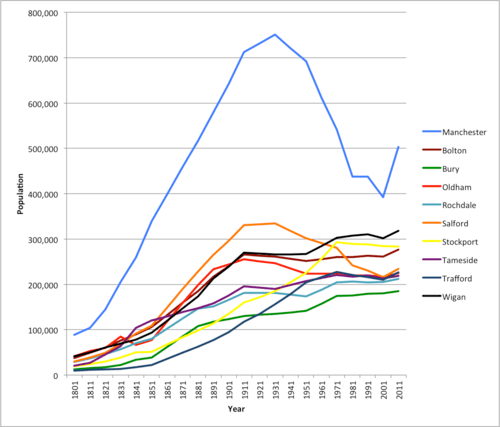
Manchester has a disproportionately high number of gay and lesbian people.[83] Of all households in Manchester, 0.23% were Same-Sex Civil Partnership couple households, compared to the English national average of 0.16% in 2011.[84]
In terms of ethnic composition, the City of Manchester has the highest non-white proportion of any district in Greater Manchester. Statistics from the 2011 census showed that 66.7% of the population was White (59.3% White British, 2.4% White Irish, 0.1% Gypsy or Irish Traveller, 4.9% Other White – although those of mixed European and British ethnic groups is unknown; there are reportedly over 25,000 Mancunians of at least partial Italian descent alone which represents 5.5% of the city's population[85]). 4.7% were mixed race (1.8% White and Black Caribbean, 0.9% White and Black African, 1.0% White and Asian, 1.0% Other Mixed), 17.1% Asian (2.3% Indian, 8.5% Pakistani, 1.3% Bangladeshi, 2.7% Chinese, 2.3% Other Asian), 8.6% Black (5.1% African, 1.6% Other Black), 1.9% Arab and 1.2% of other ethnic heritage.[86]
Kidd identifies Moss Side, Longsight, Cheetham Hill, Rusholme, as centres of population for ethnic minorities.[20] Manchester's Irish Festival, including a St Patrick's Day parade, is one of Europe's largest.[87] There is also a well-established Chinatown in the city with a substantial number of oriental restaurants and Chinese supermarkets. The area also attracts large numbers of Chinese students to the city who, in attending the local universities,[88] contribute to Manchester having the third-largest Chinese population in Europe.[89][90]
The Manchester Larger Urban Zone, a Eurostat measure of the functional city-region approximated to local government districts, has a population of 2,539,100 in 2004.[91] In addition to Manchester itself, the LUZ includes the remainder of the county of Greater Manchester.[92] The Manchester LUZ is the second largest within the United Kingdom, behind that of London.
Economy
| Year | GVA (£ million) | Growth (%) |
|---|---|---|
| 2002 | 24,011 | |
| 2003 | 25,063 | |
| 2004 | 27,862 | |
| 2005 | 28,579 | |
| 2006 | 30,384 | |
| 2007 | 32,011 | |
| 2008 | 32,081 | |
| 2009 | 33,186 | |
| 2010 | 33,751 | |
| 2011 | 33,468 | |
| 2012 | 34,755 | |
| 2013 | 37,560 | |
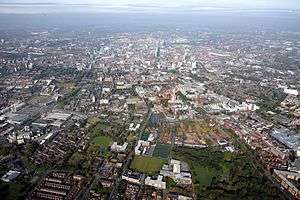
The Office for National Statistics does not produce economic data for the City of Manchester alone, but includes four other metropolitan boroughs, Salford, Stockport, Tameside, Trafford, in an area named Greater Manchester South, which had a GVA of £34.8bn. The economy grew relatively strongly between 2002 and 2012, where growth was 2.3% above the national average.[94] With a GDP of $102.3bn (2015 est., PPP) the wider metropolitan economy is the third-largest in the United Kingdom.[95] It is ranked as a beta world city by the Globalization and World Cities Research Network.[13]
As the UK economy continues to recover from the downturn experienced in 2008–10, Manchester compares favourably to other geographies according to the latest figures. In 2012 it is shown the strongest annual growth in business stock (5%) of all the Core Cities.[96] The city experienced a relatively sharp increase in the number of business deaths, the largest increase of all the Core Cities, however this was offset by strong growth in new businesses which resulted in a strong net growth.
Manchester's civic leadership has a reputation for business acumen.[97] It owns two of the country's four busiest airports and uses its earnings to fund local projects.[98] Meanwhile, KPMG's competitive alternative report found that in 2012 Manchester had the 9th lowest tax cost of any industrialised city in the world,[99] and fiscal devolution has come earlier to Manchester than to any other British city: it can keep half the extra taxes it gets from transport investment.[97]
KPMG's competitive alternative report also found that Manchester was Europe's most affordable city featured, ranking slightly better than Dutch cities, Rotterdam and Amsterdam, who all have a cost of living index less than 95.[99]
Manchester is a city of contrast, where some of the country's most deprived and most affluent neighbourhoods can be found.[100][101] According to the 2010 Indices of Multiple Deprivation Manchester is the 4th most deprived local council in England.[102] Unemployment throughout 2012–13 averaged 11.9%, which was above the national average, but lower than some of the country's other comparable large cities.[103] On the other hand, Greater Manchester is home to more multi-millionaires than anywhere outside London, with the City of Manchester taking up most of the tally.[104] In 2013 Manchester was ranked 6th in the UK for quality of life, according to a rating of the UK's 12 largest cities.[105]
Women fare better in Manchester than the rest of the country in terms of equal pay to men. The per hours worked gender pay gap is 3.3%, in contrast to 11.1% for Great Britain.[106] 37% of the working-age population in Manchester have degree level qualifications in contrast to the average of 33% across other Core Cities,[106] although schools under-perform slightly when compared to the national average.[107]
Manchester has the largest UK office market outside London according to GVA Grimley with a quarterly office uptake (averaged over 2010–14) of approximately 250,000 square ft – equivalent to the quarterly office uptake of Leeds, Liverpool and Newcastle combined and 90,000 square feet more than the nearest rival Birmingham.[108] The strong office market in Manchester has been partly attributed to 'Northshoring', (from offshoring) which entails the relocation or alternative creation of jobs away from the overheated South to areas where office space is possibly cheaper and workforce market may not be as saturated.[109]
Landmarks
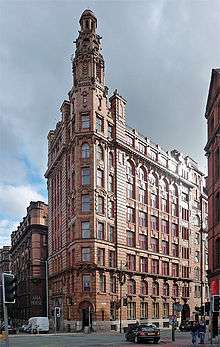
Manchester's buildings display a variety of architectural styles, ranging from Victorian to contemporary architecture. The widespread use of red brick characterises the city, much of the architecture of which harks back to its days as a global centre for the cotton trade.[23] Just outside the immediate city centre is a large number of former cotton mills, some of which have been left virtually untouched since their closure while many have been redeveloped into apartment buildings and office space. Manchester Town Hall, in Albert Square, was built in the Gothic revival style and is considered to be one of the most important Victorian buildings in England.[110] Manchester also has a number of skyscrapers built during the 1960s and 1970s, the tallest of which was the CIS Tower located near Manchester Victoria station until the Beetham Tower was completed in 2006; it is an example of the new surge in high-rise building and includes a Hilton hotel, a restaurant, and apartments. It remains the tallest building outside London and has been described as the United Kingdom's only true skyscraper outside the capital.[111] The Green Building, opposite Oxford Road station, is a pioneering eco-friendly housing project, while the recently completed One Angel Square, is one of the most sustainable large buildings in the world.[112] The award-winning Heaton Park in the north of the city borough is one of the largest municipal parks in Europe, covering 610 acres (250 ha) of parkland.[113] The city has 135 parks, gardens, and open spaces.[114]
Two large squares hold many of Manchester's public monuments. Albert Square has monuments to Prince Albert, Bishop James Fraser, Oliver Heywood, William Ewart Gladstone, and John Bright. Piccadilly Gardens has monuments dedicated to Queen Victoria, Robert Peel, James Watt and the Duke of Wellington. The cenotaph in St Peter's Square is Manchester's main memorial to its war dead; designed by Edwin Lutyens, it follows his design for the original on Whitehall in London. The Alan Turing Memorial in Sackville Park commemorates his role as the father of modern computing. A larger-than-life statue of Abraham Lincoln by George Gray Barnard in the eponymous Lincoln Square (having stood for many years in Platt Fields) was presented to the city by Mr. and Mrs. Charles Phelps Taft of Cincinnati, Ohio, to mark the part that Lancashire played in the cotton famine and American Civil War of 1861–1865.[115] A Concorde is on display near Manchester Airport.
Manchester has six designated Local Nature Reserves which are Chorlton Water Park, Blackley Forest, Clayton Vale and Chorlton Ees, Ivy Green, Boggart Hole Clough and Highfield Country Park.[116]
Transport
Rail
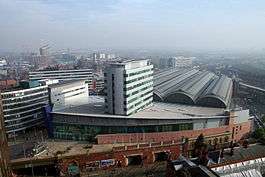
Manchester Liverpool Road was the world's first purpose-built passenger and goods railway station,[118] and served as the Manchester terminus on the Liverpool and Manchester Railway – the world's first inter-city passenger railway. Today the city is well served by the rail network,[119] and is at the centre of an extensive countywide railway network, including the West Coast Main Line, with two mainline stations: Manchester Piccadilly and Manchester Victoria. The Manchester station group – comprising Manchester Piccadilly, Manchester Victoria, Manchester Oxford Road and Deansgate – is the fourth busiest in the United Kingdom, with 41.7 million passengers recorded in 2013.[117] On 7 February 2014, construction of the £600m Northern Hub project, which aims to increase capacity and reduce journey times across the North, began with construction work commencing on a 4th platform at Manchester Airport railway station.[120] The High Speed 2 link to Birmingham and London is also planned, which, if built, will include a 12 km (7 mi) tunnel under Manchester on the final approach into an upgraded Piccadilly station.[121]
Metrolink (tram)

Manchester became the first city in the UK to acquire a modern light rail tram system when the Manchester Metrolink opened in 1992. In 2016–17, 37.8 million passenger journeys were made on the system.[123] The present system mostly runs on former commuter rail lines converted for light rail use, and crosses the city centre via on-street tram lines.[124] The network consists of seven lines with 93 stops.[125] A new line to the Trafford Centre is currently under construction and is due to open by 2020.[126][127] Manchester city centre is also serviced by over a dozen heavy and light rail-based park and ride sites.[128]
Bus
The city has one of the most extensive bus networks outside London with over 50 bus companies operating in the Greater Manchester region radiating from the city. In 2011, 80% of public transport journeys in Greater Manchester were made by bus, amounting to 220 million passenger journeys by bus each year.[129] Following deregulation in 1986, the bus system was taken over by GM Buses, which after privatisation was split into GM Buses North and GM Buses South and at a later date these were taken over by First Greater Manchester and Stagecoach Manchester respectively.[130] First Greater Manchester also operates a three route zero-fare bus service, called Metroshuttle, which carries 2.8 million commuters a year[129] around Manchester's business districts.[131] Stagecoach Manchester is the Stagecoach Group's largest subsidiary and operates around 690 buses.[132]
Air
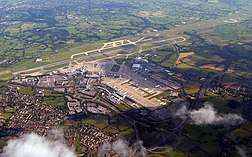
Manchester, Northern England and North Wales are served by Manchester Airport. The airport is the third busiest in the United Kingdom and the largest outside the London region. Airline services exist to many destinations in Europe, North America, the Caribbean, Africa, the Middle East and Asia (with more destinations from Manchester than any other airport in Britain).[133] A second runway was opened in 2001 and there have been continued terminal improvements. The airport has the highest rating available: "Category 10", encompassing an elite group of airports which are able to handle "Code F" aircraft including the Airbus A380 and Boeing 747-8.[134] From September 2010 the airport became one of only 17 airports in the world and the only UK airport other than Heathrow Airport to operate the Airbus A380.[135]
A smaller airfield, City Airport Manchester, also exists 9.3 km (6 mi) to the west of Manchester city centre. It was Manchester's first municipal airport, and became the site of the first Air traffic control tower in the UK, and the first municipal airfield in the UK to be licensed by the Air Ministry.[136] Today, private charter flights and general aviation use the airfield, it also has a flight school,[137] and both the Greater Manchester Police Air Support Unit and the North West Air Ambulance have helicopters based at the airfield.
Canal
An extensive canal network, including the Manchester Ship Canal, was built to carry freight from the Industrial Revolution onward; the canals are still maintained, though now largely repurposed to leisure use.[138] In 2012, plans were approved to introduce a water taxi service between Manchester city centre and MediaCityUK at Salford Quays.[139]
Culture
Music
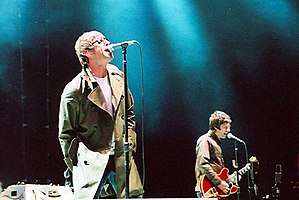
Bands that have emerged from the Manchester music scene include Oasis, The Smiths, Joy Division and its successor group New Order, Buzzcocks, The Stone Roses, The Fall, The Durutti Column, 10cc, Godley & Creme, The Verve, Elbow, Doves, The Charlatans, M People, The 1975, Simply Red, Take That, Dutch Uncles, Everything Everything, Pale Waves and The Outfield. Manchester was credited as the main driving force behind British indie music of the 1980s led by The Smiths, later including The Stone Roses, Happy Mondays, Inspiral Carpets, and James. The later groups came from what became known as the "Madchester" scene that also centred on The Haçienda nightclub developed by founder of Factory Records Tony Wilson. Although from southern England, The Chemical Brothers subsequently formed in Manchester.[140] Former Smiths frontman Morrissey, whose lyrics often refer to Manchester locations and culture, later found international success as a solo artist. Previously, notable Manchester acts of the 1960s include The Hollies, Herman's Hermits, and Davy Jones of the Monkees (famed in the mid-1960s for not only their albums but also their American TV show) and the earlier Bee Gees, who grew up in Chorlton.[141] Another notable contemporary band from Manchester is The Courteeners consisting of Liam Fray and four close friends. Singer-songwriter Ren Harvieu is also from Greater Manchester.
.jpg)
Its main pop music venue is the Manchester Arena, which was voted "International Venue of the Year" in 2007.[142] With over 21,000 seats, it is the largest arena of its type in Europe.[142] In terms of concertgoers, it is the busiest indoor arena in the world, ahead of Madison Square Garden in New York and The O2 Arena in London, respectively the second- and third-busiest.[143] Other major venues include the Manchester Apollo, Albert Hall and the Manchester Academy. Smaller venues are the Band on the Wall, the Night and Day Café,[144] the Ruby Lounge,[145] and The Deaf Institute.[146]
Manchester has two symphony orchestras, the Hallé and the BBC Philharmonic. There is also a chamber orchestra, the Manchester Camerata. In the 1950s, the city was home to the so-called "Manchester School" of classical composers, which comprised Harrison Birtwistle, Peter Maxwell Davies, David Ellis and Alexander Goehr. Manchester is a centre for musical education, with the Royal Northern College of Music, which celebrates its 40th Anniversary since its merger, and Chetham's School of Music.[147] Forerunners of the RNCM were the Northern School of Music (founded 1920) and the Royal Manchester College of Music (founded 1893), which were merged in 1973. One of the earliest instructors and classical music pianists/conductors at the RMCM, shortly after its founding was the famous Russian-born Arthur Friedheim, (1859–1932), who later had the music library at the famed Peabody Institute conservatory of music in Baltimore, Maryland, named for him. The main classical music venue was the Free Trade Hall on Peter Street, until the opening in 1996 of the 2,500 seat Bridgewater Hall.[148]
Brass band music, a tradition in the north of England, is an important part of Manchester's musical heritage;[149] some of the UK's leading bands, such as the CWS Manchester Band and the Fairey Band, are from Manchester and surrounding areas, and the Whit Friday brass band contest takes place annually in the neighbouring areas of Saddleworth and Tameside.
Performing arts
.jpg)
Manchester has a thriving theatre, opera and dance scene, and is home to a number of large performance venues, including the Manchester Opera House, which feature large-scale touring shows and West End productions; the Palace Theatre; and the Royal Exchange Theatre in Manchester's former cotton exchange, the largest theatre in the round space in the UK.
Smaller performance spaces include the Contact Theatre and Z-arts in Hulme. The Dancehouse on Oxford Road is dedicated to dance productions.[150] In 2014, HOME, a new custom built arts complex opened in the City. Housing two theatre spaces, five cinemas and an art exhibition space, it replaced the Cornerhouse and The Library Theatre.[151]
Since 2007 the city has hosted the Manchester International Festival, a biennial international arts festival with a specific focus on original new work, which has included major new commissions by artists including Bjork. In Chancellor George Osborne's 2014 autumn statement he announced a £78 million grant to fund a new "large-scale, ultra-flexible arts space" for the city.[152] Subsequently, the council stated that they had managed to secure a further £32 million from "a variety of sources",[153] The £110 million venue was confirmed in July 2016.[154]:13–14 The theatre, to be called The Factory, after Manchester's Factory Records, will provide a permanent home for the Manchester International Festival,[152] it is due to open at the end of 2019.[154]:15
Museums and galleries

Manchester's museums celebrate Manchester's Roman history, rich industrial heritage and its role in the Industrial Revolution, the textile industry, the Trade Union movement, women's suffrage and football. A reconstructed part of the Roman fort of Mamucium is open to the public in Castlefield. The Museum of Science and Industry, housed in the former Liverpool Road railway station, has a large collection of steam locomotives, industrial machinery, aircraft and a replica of the world's first stored computer program (known as the Manchester Baby).[155] The Museum of Transport displays a collection of historic buses and trams.[156] Trafford Park in the neighbouring borough of Trafford is home to Imperial War Museum North.[157] The Manchester Museum opened to the public in the 1880s, has notable Egyptology and natural history collections.[158]
The municipally owned Manchester Art Gallery on Mosley Street houses a permanent collection of European painting, and has one of Britain's most significant collections of Pre-Raphaelite paintings.[159][160]
In the south of the city, the Whitworth Art Gallery displays modern art, sculpture and textiles and was recently voted Museum of the Year in 2015.[161] Other exhibition spaces and museums in Manchester include Islington Mill in Salford, the National Football Museum at Urbis, Castlefield Gallery, the Manchester Costume Gallery at Platt Fields Park, the People's History Museum and the Manchester Jewish Museum.[162]
The works of Stretford-born painter L. S. Lowry, known for his "matchstick" paintings of industrial Manchester and Salford, can be seen in both the city and Whitworth Manchester galleries, and at the Lowry art centre in Salford Quays (in the neighbouring borough of Salford) devotes a large permanent exhibition to his works.[163]
Literature
Manchester is a UNESCO City of Literature known for possessing a "radical literary history".[164][165] In the 19th century, Manchester featured in works highlighting the changes that industrialisation had brought to Britain. These included Elizabeth Gaskell's novel Mary Barton: A Tale of Manchester Life (1848),[166] and studies such as The Condition of the Working Class in England in 1844, written by Friedrich Engels while living and working in Manchester.[167] Manchester was the meeting place of Engels and Karl Marx. The two began writing The Communist Manifesto in Chetham's Library. The library was founded in 1653 and lays claim to being the oldest public library in the English-speaking world. Elsewhere in the city, the John Rylands Library holds an extensive collection of early printing. The Rylands Library Papyrus P52, believed to be the earliest extant New Testament text, is on permanent display in the library.
Charles Dickens is reputed to have set his novel Hard Times in the city, and while it is partly modelled on Preston, it shows the influence of his friend Mrs Gaskell.[168] Gaskell penned all her novels, with the exception of Mary Barton, at her residence on Plymouth Grove. On numerous occasions Gaskell's house played host to influential authors including Dickens, Charlotte Brontë, Harriet Beecher Stowe and Charles Eliot Norton.[169] It is now open as a literary museum.
Charlotte Brontë began writing her masterpiece Jane Eyre in 1846, while staying lodgings in Hulme. Brontë was accompanying her father Patrick, who was convalescing in the city, having visited to undergo cataract surgery.[170] She likely envisioned Manchester Cathedral churchyard as the burial place for Jane's parents and the birthplace of Jane herself.[171] Also closely associated with the city is Victorian poet and novelist Isabella Banks, most famed for her 1876 novel The Manchester Man. Anglo-American author Frances Hodgson Burnett was born in the city's Cheetham Hill district in 1849, and wrote much of her classic children's novel The Secret Garden while visiting nearby Salford's Buile Hill Park.[172]
Anthony Burgess is among the 20th century writers who made Manchester their home, he wrote the dystopian satire A Clockwork Orange in 1962.[173] Dame Carol Ann Duffy, the current Poet Laureate, moved to the city in 1996 and lives in West Didsbury.[174] Poet, novelist and academic Jackie Kay also lives in the city. John Cooper Clarke the performance poet who first became famous during the punk rock era of the late 1970s when he became known as a "punk poet" grew up here.
Nightlife
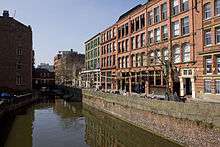
The night-time economy of Manchester has expanded significantly since about 1993, with investment from breweries in bars, public houses and clubs, along with active support from the local authorities.[175] The more than 500 licensed premises[176] in the city centre have a capacity to deal with more than 250,000 visitors,[177] with 110–130,000 people visiting on a typical weekend night,[176] making Manchester the most popular city for events at 79 per thousand people.[178] The night-time economy has a value of about £100 million[179] and supports 12,000 jobs.[176]
The Madchester scene of the 1980s, from which groups including New Order, The Smiths, The Stone Roses, the Happy Mondays, Inspiral Carpets, 808 State, James and The Charlatans emerged, was based on clubs such as the world-famous The Haçienda.[180] The period was the subject of the film 24 Hour Party People. Many of the big clubs suffered problems with organised crime at that time; Haslam describes one where staff were so completely intimidated that free admission and drinks were demanded (and given) and drugs were openly dealt.[180] Following a series of drug-related violent incidents, The Hacienda closed in 1998. In 1988, Manchester was often referred to as Madchester for its rave scene. Owned by Tony Wilson's Factory Records, it was given the catalogue number FAC51 and official club name, FAC51 The Hacienda. Known for developing many talented 1980s influential acts, it also influenced the graphic design industry via Factory artists such as Peter Saville (PSA), Octavo (8vo), Central Design Station, etc. The memorabilia from this club holds a high value among collectors and fans of these artists and the club. Peter Saville was most notable for his minimalistic influence that still affects contemporary graphic design everywhere.
Gay Village
Public houses in the Canal Street area have had an LGBTQ+ clientele since at least 1940,[175] and now form the centre of Manchester's LGBT+ community. Since the opening of new bars and clubs, the area attracts 20,000 visitors each weekend[175] and has hosted a popular festival, Manchester Pride, each August since 2003.[181]
Education

There are three universities in the City of Manchester. The University of Manchester, Manchester Metropolitan University and Royal Northern College of Music. The University of Manchester is the largest full-time non-collegiate university in the United Kingdom and was created in 2004 by the merger of Victoria University of Manchester founded in 1904 and UMIST, founded in 1956,[182] though the university's logo appears to claim it was established in 1824. It includes the Manchester Business School, which offered the first MBA course in the UK in 1965. Manchester Metropolitan University was formed as Manchester Polytechnic on the merger of three colleges in 1970. It gained university status in 1992, and in the same year absorbed Crewe and Alsager College of Higher Education in South Cheshire.[183] The University of Law, the largest provider of vocation legal training in Europe, has a campus in the city.[184]
The three Universities are grouped around Oxford Road on the southern side of the city centre, which forms Europe's largest urban higher education precinct.[185] Together they have a combined population of 76,025 students in higher education as of 2015,[186] although almost 6,000 of them were based at Manchester Metropolitan University's campuses at Crewe and Alsager in Cheshire.[187]
One of Manchester's most notable secondary schools is the Manchester Grammar School. Established in 1515,[188] as a free grammar school next to what is now the Cathedral, it moved in 1931 to Old Hall Lane in Fallowfield, south Manchester, to accommodate the growing student body. In the post-war period, it was a direct grant grammar school (i.e. partially state funded), but it reverted to independent status in 1976 after abolition of the direct-grant system.[189] Its previous premises are now used by Chetham's School of Music. There are three schools nearby: William Hulme's Grammar School, Withington Girls' School and Manchester High School for Girls.
In 2010, the Manchester Local Education Authority was ranked last out of Greater Manchester's ten LEAs – and 147th out of 150 in the country LEAs – based on the percentage of pupils attaining at least five A*-C grades at General Certificate of Secondary Education (GCSE) including maths and English (38.6% compared with the national average of 50.7%). The LEA also had the highest occurrence of absences, with 11.11% of "half-day sessions missed by pupils", above the national average of 5.8%.[190][191] Of the schools in the LEA with 30 or more pupils, four had 90% or more pupils achieving at least five A*–C grades at GCSE including maths and English (Manchester High School for Girls, St Bede's College, Manchester Islamic High School for Girls, and The King David High School) while three managed 25% or below (Plant Hill Arts College, North Manchester High School for Boys, Brookway High School and Sports College).[192]
Sport

Manchester is well known for being a city of sport.[193] Two decorated Premier League football clubs bear the city name – Manchester United and Manchester City.[194] Although Manchester United play its home games at Old Trafford, in the neighbouring Greater Manchester borough of Trafford, the largest club football ground in the United Kingdom.[195] Manchester City's home ground is the City of Manchester Stadium (also known as the Etihad Stadium for sponsorship purposes); its former ground, Maine Road was demolished in 2003. The City of Manchester Stadium was initially built as the main athletics stadium for the 2002 Commonwealth Games and was subsequently reconfigured into a football stadium before Manchester City's arrival. Manchester has hosted domestic, continental and international football competitions at Fallowfield Stadium, Maine Road, Old Trafford and the City of Manchester Stadium. Competitions hosted in city include the FIFA World Cup (1966), UEFA European Football Championship (1996), Olympic Football (2012), UEFA Champions League Final (2003), UEFA Cup Final (2008), four FA Cup Finals (1893, 1911, 1915, 1970) and three League Cup Finals (1977, 1978, 1984).
First class sporting facilities were built for the 2002 Commonwealth Games, including the City of Manchester Stadium, the National Squash Centre and the Manchester Aquatics Centre.[196] Manchester has competed twice to host the Olympic Games, beaten by Atlanta for 1996 and Sydney for 2000. The National Cycling Centre includes a velodrome, BMX Arena and Mountainbike trials and is the home of British Cycling, UCI ProTeam Team Sky and Sky Track Cycling. The Manchester Velodrome was built as a part of the bid for the 2000 games and has become a catalyst for British success in cycling.[175] The velodrome hosted the UCI Track Cycling World Championships for a record third time in 2008. The National Indoor BMX Arena (2,000 capacity) adjacent to the velodrome opened in 2011. The Manchester Arena hosted the FINA World Swimming Championships in 2008.[197] Manchester Cricket Club evolved into Lancashire County Cricket Club and play at Old Trafford Cricket Ground. Manchester also hosted the World Squash Championships in 2008,[198] and also hosted the 2010 World Lacrosse Championship in July 2010.[199] Recent sporting events hosted by Manchester include the 2013 Ashes series, 2013 Rugby League World Cup and the 2015 Rugby World Cup.
Media
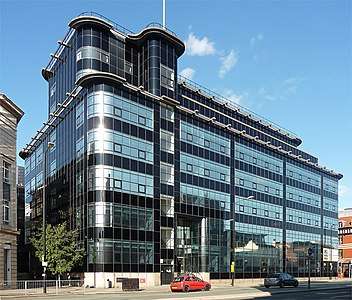
The ITV franchise Granada Television is partially headquartered in the old Granada Studios site on Quay Street and the new location at MediaCityUK[200] as part of the initial phase of its migration to Salford Quays.[201] It produces Coronation Street,[202] local news and programmes for North West England. Although its influence has waned Granada had been described as 'the best commercial television company in the world'.[203][204]
Manchester was one of the BBC's three main centres in England.[201] Programmes including Mastermind,[205] and Real Story,[206] were made at New Broadcasting House. The Cutting It series set in the city's Northern Quarter and The Street were set in Manchester[207] as was Life on Mars. The first edition of Top of the Pops was broadcast from a studio in Rusholme on New Year's Day 1964.[208] Manchester was the regional base for BBC One North West Region programmes before it relocated to MediaCityUK in nearby Salford Quays.[209][210] The Manchester television channel, Channel M, owned by the Guardian Media Group operated from 2000 but closed in 2012.[201][211] Manchester is also covered by two internet television channels: Quays News and Manchester.tv. The city will also have a new terrestrial channel from January 2014 when YourTV Manchester, who won the OFCOM licence bid in February 2013 begins its first broadcast but in 2015 when That's Manchester took over to air on 31 May and launched on the freeview channel 8 service slot before moving to channel 7 in April 2016.
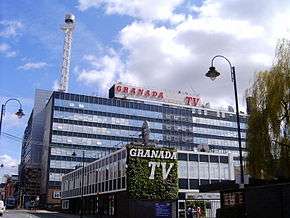
The city has the highest number of local radio stations outside London including BBC Radio Manchester, Key 103, Galaxy, Piccadilly Magic 1152, Real Radio North West, 100.4 Smooth FM, Capital Gold 1458, 96.2 The Revolution, NMFM (North Manchester FM) and Xfm.[212][213] Student radio stations include Fuse FM at the University of Manchester and MMU Radio at the Manchester Metropolitan University.[214] A community radio network is coordinated by Radio Regen, with stations covering Ardwick, Longsight and Levenshulme (All FM 96.9) and Wythenshawe (Wythenshawe FM 97.2).[213] Defunct radio stations include Sunset 102, which became Kiss 102, then Galaxy Manchester), and KFM which became Signal Cheshire (now Imagine FM). These stations and pirate radio played a significant role in the city's house music culture, the Madchester scene, which was based in clubs like The Haçienda.
The Guardian newspaper was founded in 1821 as The Manchester Guardian. Its head office is still in the city, though many of its management functions were moved to London in 1964.[20] Its sister publication, the Manchester Evening News, has the largest circulation of a UK regional evening newspaper. The paper is free in the city centre on Thursdays and Fridays, but paid for in the suburbs. Despite its title, it is available all day.[215] The Metro North West is available free at Metrolink stops, rail stations and other busy locations. The MEN group distributes several local weekly free papers.[216] For many years most of the national newspapers had offices in Manchester: The Daily Telegraph, Daily Express, Daily Mail, The Daily Mirror, The Sun. At its height, 1,500 journalists were employed, though in the 1980s office closures began and today the "second Fleet Street" is no more.[217] An attempt to launch a Northern daily newspaper, the North West Times, employing journalists made redundant by other titles, closed in 1988.[218] Another attempt was made with the North West Enquirer, which hoped to provide a true "regional" newspaper for the North West, much in the same vein as the Yorkshire Post does for Yorkshire or The Northern Echo does for the North East; it folded in October 2006.[218]
Twin cities and consulates
Manchester has formal twinning arrangements (or "friendship agreements") with several places.[219][220] In addition, the British Council maintains a metropolitan centre in Manchester.[221]









Manchester is home to the largest group of consuls in the UK outside London. The expansion of international trade links during the Industrial Revolution led to the introduction of the first consuls in the 1820s and since then over 800, from all parts of the world, have been based in Manchester. Manchester hosts consular services for most of the north of England.[223]
Honorary citizens
On 12 July 2017, American singer Ariana Grande became the first honorary citizen of Manchester, after a unanimous vote by the Manchester City Council.[224]
See also
References
- ↑ "Manchester's Lord Mayor". Manchester.gov.uk. Retrieved 24 July 2015.
- ↑ "Eurostat – Data Explorer". Eurostat. Retrieved 27 August 2018.
- 1 2 3 "2011 Census – Key statistics for local authorities in England and Wales". ONS. Retrieved 7 November 2013.
- 1 2 "Global city GDP 2013–2014". Brookings Institution. Retrieved 25 March 2015.
- ↑ Wells, John C. (2008), Longman Pronunciation Dictionary (3rd ed.), Longman, ISBN 9781405881180
- ↑ Roach, Peter (2011), Cambridge English Pronouncing Dictionary (18th ed.), Cambridge: Cambridge University Press, ISBN 9780521152532
- ↑ "Population estimates for UK, England and Wales, Scotland and Northern Ireland". www.ons.gov.uk. Office for National Statistics. 28 June 2018. Retrieved 16 July 2018.
- ↑ "Labour Market Profile – Greater Manchester (Met County)". Office for National Statistics. Retrieved 10 April 2018.
- ↑ The first to be included, Wythenshawe, was added to the city in 1931.
- ↑ Aspin, Chris (1981). The Cotton Industry. Shire Publications Ltd. p. 3. ISBN 0-85263-545-1.
- ↑ Kidd, Alan (2006). Manchester: A History. Lancaster: Carnegie Publishing. ISBN 1-85936-128-5.
• Frangopulo, Nicholas (1977). Tradition in Action. The historical evolution of the Greater Manchester County. Wakefield: EP Publishing. ISBN 0-7158-1203-3.
• "Manchester – the first industrial city". Entry on Sciencemuseum website. Archived from the original on 9 March 2012. Retrieved 17 March 2012. - ↑ Williams, Jennifer (15 June 2016). "Recap: The IRA bomb in Manchester... what happened on June 15, 1996". Archived from the original on 17 August 2016.
- 1 2 "The World According to GaWC 2012". Globalization and World Cities Research Network. Retrieved 25 March 2014.
- ↑ "London visited by 50% of UK's tourists". BBC News. Retrieved 21 May 2013.
- ↑ The Antiquaries Journal ( ISSN 0003-5815) 2004, vol. 84, pp. 353–357
- ↑ Mills, A.D. (2003). A Dictionary of British Place-Names. Oxford: Oxford University Press. ISBN 0-19-852758-6. Retrieved 7 November 2013.
- 1 2 Cooper, Glynis (2005). Salford: An Illustrated History. The Breedon Books Publishing Company. p. 19. ISBN 1-85983-455-8.
- ↑ Rogers, Nicholas (2003). Halloween: from Pagan Ritual to Party Night. Oxford University Press. p. 18. ISBN 0-19-516896-8. Retrieved 7 November 2013.
- ↑ Gregory, Richard (ed) (2007). Roman Manchester: The University of Manchester's Excavations within the Vicus 2001–5. Oxford: Oxbow Books. p. 190. ISBN 978-1-84217-271-1.
- 1 2 3 4 5 6 7 8 9 10 11 12 13 14 Kidd, Alan (2006). Manchester: A History. Lancaster: Carnegie Publishing. pp. 12, 15–24, 224. ISBN 1-85936-128-5.
- 1 2 3 4 Hylton, Stuart (2003). A History of Manchester. Phillimore & Co. pp. 1–10, 22, 25, 42, 63–67, 69. ISBN 1-86077-240-4.
- ↑ Arrowsmith, Peter (1997). Stockport: a History. Stockport Metropolitan Borough Council. p. 30. ISBN 0-905164-99-7.
- 1 2 3 4 Hartwell, Clare (2001). Pevsner Architectural Guides: Manchester. London: Penguin Books. pp. 11–17, 155, 256, 267–268. ISBN 0-14-071131-7.
- 1 2 Nicholls, Robert (2004). Curiosities of Greater Manchester. Sutton Publishing. ISBN 0-7509-3661-4.
- ↑ Letters, Samantha (2005). Gazetteer of Markets and Fairs in England and Wales to 1516. British History Online. p. 19. Retrieved 5 May 2009.
- 1 2 Pevsner, Nikolaus (1969). Lancashire, The Industrial and Commercial South. London: Penguin Books. p. 265. ISBN 0-14-071036-1.
- ↑ Durston, Christopher (2001). Cromwell's major generals: godly government during the English Revolution. Politics, culture, and society in early modern Britain. Manchester: Manchester University Press. ISBN 0-7190-6065-6. Retrieved 5 May 2009.
- 1 2 3 4 5 McNeil, Robina; Michael Nevell (2000). A Guide to the Industrial Archaeology of Greater Manchester. Association for Industrial Archaeology. ISBN 0-9528930-3-7.
- 1 2 Hall, Peter (1998). "The first industrial city: Manchester 1760–1830". Cities in Civilisation. London: Weidenfeld & Nicolson. ISBN 0-297-84219-6.
- ↑ "Manchester". Oxford English Dictionary. Oxford: Oxford University Press. March 2016. Retrieved 17 December 2016.
- ↑ "Timelines.tv Urban Slums". Timelines.tv. Archived from the original on 18 February 2012. Retrieved 2 February 2012.
- ↑ Schofield, Jonathan. "Manchester: migrant city". BBC Manchester:New Kids From The Bloc. BBC. Retrieved 6 April 2013.
- ↑ Aspin, Chris (1981). The Cotton Industry. Aylesbury: Shire Publications. p. 3. ISBN 0-85263-545-1.
- ↑ "Events in Telecommunications History". BT Archives. 1878. Retrieved 13 March 2015.
- ↑ "About Us". Peel Ports. Retrieved 16 March 2015.
- ↑ "Marx-Engels Internet Archive – Biography of Engels". Marx/Engels Biography Archive. 1893. Retrieved 5 May 2009.
- ↑ Kidd, Alan (2006). "Chapter 9 England Arise! The Politics of Labour and Women's Suffrage". Manchester: A history. Lancaster: Carnegie Publishing. ISBN 1-85936-128-5.
- ↑ Speake, Jennifer, ed. (2003). The Oxford Dictionary of Proverbs (4th ed.). Oxford University Press. ISBN 0-19-860524-2. Retrieved 6 July 2007.
What Manchester says today, the rest of England says tomorrow
•Osborne, George (7 March 2007). "Osborne: Our vision to make Manchester the creative capital of Europe". Conservative Party Website. Conservative Party. Archived from the original on 28 June 2009. Retrieved 4 May 2009.The saying goes that what Manchester does today the rest of the world does tomorrow.
•"Manchester Life". Manchester Metropolitan University. 2007. Archived from the original on 8 November 2007. Retrieved 5 May 2009.What Manchester does today, the world does tomorrow
- ↑ Simon Schama (presenter) (4 June 2002). "Victoria and Her Sisters". A History of Britain. Episode 13. BBC One.
- ↑ Hardy, Clive (2005). "The blitz". Manchester at War (2nd ed.). Altrincham: First Edition Limited. pp. 75–99. ISBN 1-84547-096-6.
- ↑ "Timeline". Manchester Cathedral Online. 2008. Retrieved 5 May 2009.
- ↑ Parkinson-Bailey, John J (2000). Manchester: an Architectural History. Manchester: Manchester University Press. p. 127. ISBN 0-7190-5606-3.
• Pevsner, Nikolaus (1969). Lancashire, The Industrial and Commercial South. London: Penguin Books. p. 267. ISBN 0-14-071036-1. - ↑ "Salford Quays milestones: the story of Salford Quays" (PDF). Salford City Council. 2005. Archived from the original (PDF) on 27 March 2009. Retrieved 5 May 2009.
- ↑ Sengupata, Kim (28 March 1997). "£411m cost after Manchester bomb sets record". London: The Independent. Retrieved 3 October 2009.
- 1 2 Hartwell, Clare (2001). Pevsner Architectural Guides: Manchester. London: Penguin Books. ISBN 0-14-071131-7.
• Parkinson-Bailey, John J (2000). Manchester: an Architectural History. Manchester: Manchester University Press. ISBN 0-7190-5606-3.
• Hartwell, Clare; Hyde, Matthew; Pevsner, Nikolaus (2004). Lancashire: Manchester and the South-East. New Haven & London: Yale University Press. ISBN 0-300-10583-5. Retrieved 7 November 2013. - ↑ Hylton, Stuart (2003). A History of Manchester. Chichester: Phillimore & Co. pp. 227–230. ISBN 1-86077-240-4.
- ↑ "Panorama – The cost of terrorism". BBC. 15 May 2004. Retrieved 5 May 2009.
- ↑ "Manchester Arndale". Prudential plc. 2007. Retrieved 9 October 2008.
- ↑ "City building reaches full height". BBC. 26 April 2006. Retrieved 9 October 2008.
- ↑ "Greenwich loses Casino Bet". BBC. 15 February 2007. Retrieved 9 October 2008.
- ↑ Ottewell, David (26 February 2008). "Empty promises and spin". Manchester Evening News. M.E.N. media. Archived from the original on 30 January 2013. Retrieved 9 October 2008.
- ↑ "With Manchester Festival, England's second city bids for cultural spotlight". LA Times. 3 July 2007. Retrieved 5 May 2009.
- ↑ "Manchester poll 'England's second city'". Ipsos MORI North. 2002. Retrieved 3 February 2012.
- ↑ "Prescott ranks Manchester as second city". Manchester Evening News. M.E.N media. 3 February 2005. Archived from the original on 10 November 2013. Retrieved 5 May 2009.
We have had fantastic co-operation here in Manchester—our second city, I am prepared to concede.
- ↑ "Manchester 'close to second city'". BBC News. 29 September 2005. Retrieved 5 May 2009.
- 1 2 "Manchester 'England's second city'". BBC News. 12 September 2002. Retrieved 5 May 2009.
•"Manchester tops second city poll". BBC News. 10 February 2007. Retrieved 5 May 2009.
•"Birmingham loses out to Manchester in second city face off". BBC. 9 February 2007. Retrieved 5 May 2009. - ↑ "About the Core Cities Group". English Core Cities Group. 2004. Archived from the original on 19 September 2007. Retrieved 9 July 2007.
- 1 2 3 4 5 6 7 8 "Greater Manchester Gazetteer". Greater Manchester County Record Office. Places names – M to N. Archived from the original on 11 February 2011. Retrieved 9 July 2007.
- ↑ Frangopulo, Nicholas (1977). Tradition in Action. The historical evolution of the Greater Manchester County. Wakefield: EP Publishing. ISBN 0-7158-1203-3.
- ↑ Phillip Inman (16 May 2015). "Perils of the 'Northern Powerhouse': is devolution a mixed blessing". The Guardian. Retrieved 17 May 2015.
- ↑ Kidd, Alan (2006). Manchester: A History. Lancaster: Carnegie Publishing. p. 11. ISBN 1-85936-128-5.
- ↑ "The Manchester Coalfields" (PDF). Museum of Science and Industry in Manchester. 2001. Archived from the original (PDF) on 27 March 2009. Retrieved 5 May 2009.
- ↑ "Heaton Park". thecgf.com. Retrieved 20 July 2009.
- 1 2 "Manchester Airport 1971–2000 weather averages". Met Office. 2001. Archived from the original on 29 September 2007. Retrieved 5 May 2009.
- 1 2 "UK 1971–2000 averages". Met Office. 2001. Archived from the original on 5 July 2009. Retrieved 5 May 2009.
- ↑ Smith, Wilfred (1959). "II". An Economic Geography of Great Britain. Taylor and Francis. p. 470.
- ↑ "Roads chaos as snow sweeps in Manchester". Manchester Evening News. 24 February 2005. Archived from the original on 2 November 2013. Retrieved 5 May 2009.
- ↑ "Snow: West Yorkshire traffic and travel latest". Halifax Courier. Halifax Courier. Retrieved 9 November 2017.
- ↑ "Peak District sightseer's guide – Snake Pass". High Peak. 2002. Retrieved 5 May 2009.
- ↑ "Live: M62 motorway closed and 20 miles of queues as snow and high winds return to Greater Manchester". Manchester Evening News. Manchester Evening News. Retrieved 9 November 2017.
- ↑ https://www.manchestereveningnews.co.uk/news/greater-manchester-news/minus-176c---big-freeze-880053
- ↑ "Manchester 1981-2010 Averages". Met Office. Retrieved 30 January 2016.
- ↑ "Manchester Ringway 1961-1990". NOAA. Retrieved 30 January 2016.
- ↑ "Manchester ringway extreme values". KNMI. Retrieved 30 January 2016.
- ↑ "Manchester ringway 1981-2010 mean extreme values". KNMI. Retrieved 2 January 2018.
- 1 2 "Local Development Framework Evidence Base Green Belt Review July 2010" (PDF). www.manchester.gov.uk.
- ↑ "Urban Density -v- Suburban Sprawl – The Leader's Blog". www.manchester.gov.uk.
- ↑ "Manchester's Local Development Framework Core Strategy Development Plan Document Adopted 11th July 2012 Published by Manchester City Council" (PDF). www.manchester.gov.uk.
- ↑ Shapely, Peter (2002–2003). "The press and the system built developments of inner-city Manchester" (PDF). Manchester Region History Review. Manchester: Manchester Centre for Regional History. 16: 30–39. ISSN 0952-4320. Archived from the original (PDF) on 10 February 2012. Retrieved 22 November 2007.
- 1 2 3 4 "Public Intelligence Population Publications". Manchester City Council. 1 April 2005. Retrieved 9 August 2014.
- ↑ Townsend, Lucy; Westcott, Kathryn (17 July 2012). "Census 2011: Five lesser-spotted things in the data". BBC News. Retrieved 9 August 2014.
- ↑ "Second largest". Something Jewish. Retrieved 14 September 2007.
- ↑ Robehmed, Sophie (9 February 2012). "Why is Hebden Bridge the lesbian capital?". BBC News. Retrieved 9 August 2014.
- ↑ "Manchester Neighbourhood Statistics – Same-Sex couples". Office for National Statistics. 2001. Archived from the original on 3 March 2014. Retrieved 26 February 2014.
- ↑ Green, David (29 November 2003). "Italians revolt over church closure". BBC News. Retrieved 12 May 2010.
- ↑ "2011 Census: Ethnic group, local authorities in England and Wales". ONS. Retrieved 12 December 2012.
- ↑ "The Manchester Irish Festival: the largest in the UK". Manchester Irish Festival Website. 2007. Retrieved 28 June 2007.
- ↑ "History of Manchester's Chinatown". BBC. 2004. Retrieved 22 November 2007.
- ↑ "Manchester Airport celebrates Diwali and Eid". MAG Airports Group. 2011. Archived from the original on 13 March 2012. Retrieved 7 September 2012.
- ↑ "Airport City bosses in £650m China mission". Manchester Evening News. 2012. Archived from the original on 17 January 2014. Retrieved 7 September 2012.
- ↑ "Urban Audit – City Profiles: Manchester". Urban Audit. Archived from the original on 12 January 2013. Retrieved 5 October 2008.
- ↑ "Towards a Common Standard" (PDF). Greater London Authority. p. 29. Archived from the original (PDF) on 17 December 2008. Retrieved 5 October 2008.
- ↑ "Regional Gross Value Added (Income Approach) NUTS3 Tables". Office for National Statistics. 2013. Retrieved 9 August 2014.
- ↑ "The Leeds Economy" (PDF). Leeds City Council. 2004. Archived from the original (PDF) on 1 January 2014. Retrieved 9 August 2014.
- ↑ Istrate, Emilia; Nadeau, Carey Anne (November 2012). "Global MetroMonitor". Washington, DC: The Brookings Institution. Retrieved 28 March 2015.
- ↑ "Release Edition Reference Tables: Business Demography, 2012". Office for National Statistics. 27 November 2013. Retrieved 9 August 2014.
- 1 2 "Cities: The vacuum cleaners". The Economist. 9 November 2013. Retrieved 9 August 2014.
- ↑ "Manchester Airports Group dividend windfall for councils". BBC News. 31 July 2013. Retrieved 9 August 2014.
- 1 2 Moonen, Tim; Clark, Greg (November 2013). "The Business of Cities 2013" (PDF). Jones Lang LaSalle IP. pp. 78–79. Archived (PDF) from the original on 18 October 2015. Retrieved 9 August 2014.
- ↑ "South Manchester: Living in the area: Introducing South Manchester". Manchester City Council. Archived from the original on 15 July 2014. Retrieved 9 August 2014.
- ↑ "Wealth hotspots 'outside London'". BBC News. 7 July 2004. Retrieved 9 August 2014.
- ↑ "The English Indices of Deprivation 2010: Local Authorities District Summaries File Notes". Department for Communities and Local Government. 2010. Retrieved 9 August 2014.
- ↑ "Labour Market Profile: Manchester". Office for National Statistics. 2010. Archived from the original on 17 July 2011. Retrieved 9 August 2014.
- ↑ Robson, Steve (17 September 2012). "Boom city Manchester has more super-rich than anywhere outside London". Manchester Evening News. Archived from the original on 31 December 2013. Retrieved 9 August 2014.
- ↑ Philipson, Alice (18 October 2013). "Bristol is 'best city to live in the UK'". The Telegraph. Retrieved 9 August 2014.
- 1 2 "Labour Market Profile: Manchester". Office for National Statistics. 2013. Retrieved 9 August 2014.
- ↑ "Education and skills in your area: Manchester LA". Department for Education. 2012. Retrieved 9 August 2014.
- ↑ "The Big Nine – Regional Office Review – Q4 2014". GVA Grimley. 2015. Retrieved 16 March 2015.
- ↑ Oglesby, Chris (17 August 2012). "Prepare for regional renaissance as businesses favour 'northshoring'". propertyweek.com. Retrieved 30 September 2014.
- ↑ Robinson (1986), The Architecture of Northern England, p. 153
- ↑ John Sunyer (22 March 2013). "View from the top: At home (in Manchester) with Ian Simpson, one of the architects transforming the face of London". FT.com. Retrieved 26 November 2014.
- ↑ "One Angel Square, Co-operative Group HQ". breeam.org. Archived from the original on 21 May 2013. Retrieved 14 March 2013.
- ↑ "About Heaton Park". Manchester City Council. 2005. Archived from the original on 15 March 2008. Retrieved 23 November 2007.
- ↑ "Manchester's parks and open spaces". Manchester City Council. 2005. Retrieved 23 November 2007.
- ↑ Cocks, Harry; Wyke, Terry (2004). Public Sculpture of Greater Manchester. Public Sculpture of Britain. Liverpool: Liverpool University Press. pp. 11–27, 88–92, 111–121, 123–5, 130–2. ISBN 0-85323-567-8.
- ↑ "Local nature Reserves". Manchester City Council. Retrieved 27 January 2011.
- 1 2 "Estimates of station usage". Office of Rail Regulation. 22 April 2014. Retrieved 9 August 2014.
- ↑ "A History of the World : Liverpool Road Station sundial". BBC. Retrieved 9 August 2014.
- ↑ "Extra track suggested to ease Manchester's rail bottlenecks". Financial Times. 17 February 2010. Archived from the original on 16 January 2014. Retrieved 13 March 2012.
- ↑ Topham, Gwyn (7 February 2014). "George Osborne launches £600m Northern Hub rail project". The Guardian. Retrieved 9 August 2014.
- ↑ "HS2 to enter Manchester via tunnel under city". BBC News. 28 January 2013. Retrieved 9 August 2014.
- ↑ "New Metrolink line to Wythenshawe and Manchester Airport to open on November 3 – a year ahead of schedule". Manchester Evening News. 13 October 2014. Archived from the original on 18 October 2014. Retrieved 2 November 2014.
- ↑ "Light Rail and Tram Statistics: England 2016/17" (PDF). Department for Transport. Retrieved 30 June 2017.
- ↑ "Metrolink History" (PDF). Manchester Metrolink. 9 March 2004. Archived from the original (PDF) on 25 March 2009. Retrieved 21 March 2009.
- ↑ Scheerhout, John (31 March 2014). "Passenger trams start running to and from Rochdale town centre for first time in 80 years". Manchester Evening News. Retrieved 31 March 2014.
- ↑ "Metrolink's Trafford Park £350m Tramline Approved". BBC News. 13 October 2016.
- ↑ "Enabling works begin on new Trafford Park Metrolink line".
- ↑ "TFGM Park & Ride – Stations and Stops". GMPTE. 2007. Archived from the original on 22 October 2013. Retrieved 8 November 2013.
- 1 2 "2011/2012 Annual Report" (PDF). Transport for Greater Manchester. 2012. pp. 10, 16. Archived from the original (PDF) on 2 March 2014. Retrieved 9 August 2014.
- ↑ "GMPTE Trends and Statistics 2001/2002" (PDF). GMPTE. 2002. pp. 28–9. Archived from the original (PDF) on 27 March 2009. Retrieved 19 September 2007.
- ↑ Satchell, Clarissa (22 September 2005). "Free buses on another city route". Manchester Evening News. M.E.N. media. Archived from the original on 26 October 2013. Retrieved 18 September 2007.
- ↑ "Stagecoach welcomes government funding for Greater Manchester transport strategy". stagecoachplc.co.uk. 9 June 2008. Retrieved 26 September 2010.
- ↑ Wilson, James (26 April 2007). "A busy hub of connectivity". Financial Times. The Financial Times Limited.
- ↑ "Manchester Airport is Officially 'A380 Ready'". manchesterairport.co.uk. 18 August 2010. Archived from the original on 21 August 2010. Retrieved 1 September 2010.
- ↑ "Giant Airbus A380 lands at Manchester Airport". BBC News. 1 September 2010. Retrieved 9 August 2014.
- ↑ "Airport History: City Airport and Heliport". City Airport Ltd. Retrieved 9 August 2014.
- ↑ "Where to start: City Airport and Heliport". City Airport Ltd. Retrieved 9 August 2014.
- ↑ "Manchester Ship Canal". Inland Waterways Association. Retrieved 16 March 2015.
•Pivaro, Nigel (20 October 2006). "Ship canal cruising is all the rage". Manchester Evening News. M.E.N. media. Archived from the original on 10 November 2013. Retrieved 19 September 2007. - ↑ "Links". Manchester Water Taxis. Archived from the original on 22 April 2014. Retrieved 9 August 2014.
- ↑ "The Chemical Brothers – Alumni". University of Manchester. 2005. Archived from the original on 8 January 2009. Retrieved 12 November 2007.
- ↑ "Bee Gees go back to their roots". BBC News. 12 May 2004. Retrieved 12 November 2007.
- 1 2 "Pollstar Concert Industry Awards Winners Archives". Pollstar Online. 2001. Archived from the original on 12 January 2013. Retrieved 24 June 2007.
•Brown, Rachel (10 August 2007). "M.E.N Arena's world's top venue". Manchester Evening News. M.E.N. Media. Archived from the original on 26 October 2013. Retrieved 12 August 2007.The M.E.N. Arena is the top-selling venue in the world.
- ↑ "M.E.N Named Most Popular Entertainment Venue on Planet". Archived from the original on 6 December 2008. Retrieved 8 May 2008.
- ↑ "Night & Day Café". nightnday.org. Retrieved 15 July 2011.
- ↑ "The Ruby Lounge: History". therubylounge.org. Retrieved 15 July 2011.
- ↑ "Trof presents the Deaf Institute: café, bar and music hall". thedeafinstitute.co.uk. Retrieved 15 July 2011.
- ↑ Redhead, Brian (1993). Manchester: a Celebration. London: Andre Deutsch. pp. 60–61. ISBN 0-233-98816-5.
- ↑ "Good Venue Guide; 28 – Bridgewater Hall, Manchester". Independent on Sunday. 12 April 1998.
- ↑ "Procession – Jeremy Deller". Manchester International Festival. July 2009. Retrieved 24 July 2009.
- ↑ "The Dancehouse Theatre". thedancehouse.co.uk. Archived from the original on 17 February 2009. Retrieved 7 February 2009.
- ↑ Linton, Deborah (24 November 2010). "New home for Cornerhouse and Library Theatre in £19m arts centre plan". Manchester Evening News. Archived from the original on 3 February 2016.
- 1 2 "The Guardian view on Manchester's new cultural space: from one kind of factory to another". The Guardian. 5 December 2014. Retrieved 13 January 2015.
- ↑ Youngs, Ian (29 July 2015). "The Factory Manchester £110m arts venue approved". BBC. Retrieved 30 July 2015.
- 1 2 Manchester City Council (July 2016). Executive meeting: 16. Updated Draft St Johns Strategic regeneration framework and Factory Manchester (Report). Manchester City Council. Retrieved 22 July 2016. Pdf.
- ↑ "Explore MOSI". Museum of Science and Industry. 2009. Archived from the original on 6 August 2009. Retrieved 24 July 2009.
- ↑ "Vehicle Collection". Greater Manchester Museum of Transport. 2007. Archived from the original on 13 February 2010. Retrieved 24 July 2009.
- ↑ Imperial War Museum (2013). "IWM North". iwm.org.uk. Retrieved 9 March 2013.
- ↑ "The History of The Manchester Museum". University of Manchester. Archived from the original on 27 June 2009. Retrieved 24 July 2009.
- ↑ Moss, Richard (17 October 2003). "The Pre-Raphaelite Collections". 24-Hour Museum. Retrieved 24 July 2009.
- ↑ Morris, Edward (2001). Public art collections in north-west England. Liverpool University Press. p. 118. ISBN 0-85323-527-9.
- ↑ "Collection". Whitworth Gallery. Retrieved 24 July 2009.
- ↑ "Manchester Museums Guide". Virtual Manchester. 2009. Archived from the original on 30 May 2009. Retrieved 24 July 2009.
- ↑ "The Lowry Collection". The Lowry. 2009. Archived from the original on 30 March 2010. Retrieved 24 July 2009.
- ↑ Royle, Nicholas (2 November 2017). "A new chapter begins: Manchester named Unesco City of Literature". The Guardian. Retrieved 12 November 2017.
- ↑ Atkinson, David (4 October 2014). "A literary tour of Manchester". The Guardian. Retrieved 29 September 2015.
- ↑ "Elizabeth Gaskell (1810–1865)". BBC. Retrieved 2 November 2007.
- ↑ Engels, Fredrick (1892). The Condition of the Working-Class in England in 1844. London: Swan Sonnenschein & Co. pp. 45, 48–53. Retrieved 11 March 2015 – via Internet History Sourcebooks Project.
- ↑ "Charles Dickens's Hard Times for These Times as an Industrial Novel". Retrieved 20 October 2013.
- ↑ Nurden, Robert (26 March 2006). "An ending Dickens would have liked". The Independent. London. Archived from the original on 14 May 2010. Retrieved 29 September 2015.
- ↑ "Jane Eyre: a Mancunian?". BBC. 10 October 2006. Retrieved 17 July 2018.
- ↑ Alexander, Christine, and Sara L. Pearson. Celebrating Charlotte Brontë: Transforming Life into Literature in Jane Eyre. Brontë Society, 2016, p. 173.
- ↑ Keeling, Neal (3 May 2014). "Derelict Buile Hill Mansion could be turned into Hilton hotel". Manchester Evening News. Archived from the original on 30 September 2015. Retrieved 29 September 2015.
- ↑ See the essay "A Prophetic and Violent Masterpiece" by Theodore Dalrymple in "Not With a Bang but a Whimper" (2008) pp. 135–49
- ↑ Forbes, Peter (31 August 2002). "Winning lines". The Guardian. Retrieved 29 September 2015.
- 1 2 3 4 Parkinson-Bailey, John J (2000). Manchester: an Architectural History. Manchester: Manchester University Press. pp. 249–250, 284–6. ISBN 0-7190-5606-3.
- 1 2 3 Hobbs, Dick; Winlow, Simon; Hadfield, Philip; Lister, Stuart (2005). "Violent Hypocrisy: Governance and the Night-time Economy". European Journal of Criminology. 2 (2): 161. doi:10.1177/1477370805050864.
- ↑ Hobbs, Dick. "Seven Deadly Sins: A new look at society through an old lens" (PDF). Economic and Social Research Council. pp. 24–27. Archived from the original (PDF) on 8 June 2012. Retrieved 27 November 2011.
- ↑ Chadha, Aayush. "UK Event Data – In Review". www.tickx.co.uk. Retrieved 1 December 2017.
- ↑ "Guide to Manchester". BBC Sport. 16 June 2002. Retrieved 12 November 2007.
- 1 2 Haslam, Dave (2000). Manchester, England. Fourth Estate. ISBN 1-84115-146-7.
- ↑ "Europe's biggest gay festival to be held in UK". The Guardian. M.E.N media. 11 February 2003. Retrieved 20 May 2007.
- ↑ "Manchester still top of the popularity league". University of Manchester. 18 January 2007. Retrieved 6 October 2008.
- ↑ Fowler, Alan (1994). Many Arts, Many Skills: Origins of Manchester Metropolitan University. Manchester Metropolitan University. pp. 115–20, 226–8. ISBN 1-870355-05-9.
- ↑ "The College of Law". International Bar Association. Retrieved 20 January 2013.
- ↑ Hartwell, Clare (2001). Pevsner Architectural Guides: Manchester. Penguin Books. p. 105. ISBN 0-14-071131-7.
- ↑ "Table 0a – All students by institution, mode of study, level of study, gender and domicile 2006/07". Students and Qualifiers Data Tables. Higher Education Statistics Agency. 2008. Archived from the original (XLS) on 9 July 2013. Retrieved 21 March 2008.
- ↑ "History – About Us". MMU Cheshire. Manchester Metropolitan University. 2008. Archived from the original on 13 March 2011. Retrieved 6 October 2008.
- ↑ Kidd, Alan (2006). Manchester: A History. Lancaster: Carnegie Publishing. p. 206. ISBN 1-85936-128-5.
•Hylton, Stuart (2003). A History of Manchester. Phillimore & Co. p. 25. ISBN 1-86077-240-4. - ↑ Bentley, James (1990). Dare to be wise: a history of the Manchester Grammar School. James & James. pp. 108, 114, 119–121. ISBN 0-907383-04-1.
- ↑ "How different areas performed". BBC Sport. 13 January 2009. Retrieved 28 November 2010.
- ↑ "How different areas performed in school league tables". BBC News. 13 January 2010. Retrieved 28 November 2010.
- ↑ "Secondary schools in Manchester". BBC News. 13 January 2010. Retrieved 28 November 2010.
- ↑ "Manchester: Award winning city of sport". Manchester City Council. 9 May 2012. Retrieved 10 September 2012.
- ↑ White, Duncan; Smith, Rory (14 May 2011). "Manchester is a City United in celebration as both clubs end the day with silverware". The Telegraph. Retrieved 9 August 2014.
- ↑ "Football fever". Visit Manchester web pages. Visit Manchester. Archived from the original on 27 October 2007. Retrieved 6 October 2008.
• "Sporting heritage". Visit Manchester web pages. Visit Manchester. Archived from the original on 6 February 2010. Retrieved 6 October 2008. - ↑ "Sporting Legacy". Commonwealth Games Legacy Manchester 2002. Commonwealth Games Legacy. 2003. Archived from the original on 11 November 2007. Retrieved 6 October 2008.
- ↑ "9th Fina World Swimming Championships (25m)". Fina.org. 2008. Archived from the original on 4 September 2015. Retrieved 6 October 2008.
- ↑ "Hi-Tec World Squash Championships – Manchester 2008". Hi-Tec World Squash Championships Manchester 2008. 2008. Archived from the original on 15 July 2008. Retrieved 5 May 2009.
- ↑ "World Lacrosse Championships – Manchester 2010". World Lacrosse Championships 2010. 2010. Archived from the original on 11 February 2010. Retrieved 29 March 2010.
- ↑ "£1bn vision for former ITV site revealed". Archived from the original on 1 February 2016.
- 1 2 3 "The creative media industries and workforce in North West England" (PDF). skillset.org. 2008. Archived from the original (PDF) on 13 January 2011. Retrieved 6 October 2008.
- ↑ Little, Daran (1995). The Coronation Street Story. London: Boxtree. p. 6. ISBN 1-85283-464-1.
Coronation Street is without doubt the most successful television programme in the world. ... what is today the world's longest running drama serial.
- ↑ "Obituary – David Plowright". The Independent. 29 August 2006. Retrieved 4 February 2012.
As he himself liked to quote, not for nothing had Granada been dubbed the best commercial television company in the world.
- ↑ "Party People returns as presenter Rob McLoughlin celebrates thirtieth year at ITV". 25 January 2012. Archived from the original on 19 April 2012. Retrieved 4 February 2012.
The Financial Times was to claim that 'Granada was probably the best commercial TV company in the world' – with respect to Thames TV; LWT and our American cousins – they may have been right but when that quote was hauled over reception in Quay Street I found it both inspiring and daunting.
- ↑ "Championing sustainable TV production in the nations and regions" (Press release). BBC. 23 November 2005. Retrieved 6 October 2008.
- ↑ "BBC One's Real Story with Fiona Bruce series comes to end in 2007" (Press release). BBC. 15 November 2006. Retrieved 6 October 2008.
- ↑ Gans, Charles J. (19 November 2007). "International Emmys Awards to honor Al Gore". USA Today. Retrieved 6 October 2008.
- ↑ "'Top of the Pops' shows". Observer Music Monthly. London: Guardian News and Media Limited. 16 July 2006. Retrieved 6 October 2008.
- ↑ "Television & Radio Stations in Manchester". Manchester 2002 UK. 2002. Archived from the original on 22 September 2007. Retrieved 11 September 2007.
- ↑ "BBC R&D to relocate to Salford Quays". Digital TV Group. 1 June 2007. Archived from the original on 6 December 2008. Retrieved 6 October 2008.
• "BBC move to Salford gets green light" (Press release). BBC. 31 May 2007. Retrieved 6 October 2008. - ↑ Plunkett, John (16 April 2012). "Manchester's Channel M closes after 12 years". The Guardian. Retrieved 8 May 2012.
- ↑ "A Guide to Radio Stations in and Around North West England". northwestradio.info. 2005. Retrieved 8 November 2007.
- 1 2 See Radio at the Ofcom web site and subpages, especially the directory of analogue radio stations, the map"Commercial Radio Styles" (PDF). Archived from the original on 4 March 2009. Retrieved 14 December 2015. (PDF), and the map"Community Radio in the UK" (PDF). Archived from the original on 14 April 2010. Retrieved 14 December 2015. (PDF). Retrieved on 6 November 2007
- ↑ "FUSE FM – Manchester Student Radio". fusefm.co.uk. Archived from the original on 19 September 2008. Retrieved 6 October 2008.
- ↑ Sweney, Mark (30 August 2007). "Paid-for sales of MEN slump". The Guardian. UK: Guardian News and Media Limited. Retrieved 6 October 2008.
- ↑ "M.E.N. Makes Changes To Metro Distribution". Merry Media News. 9 March 2007. Archived from the original on 22 October 2007. Retrieved 6 October 2008.
• "manchester local press". ManchesterOnline. GMG Regional Digital. 2007. Archived from the original on 12 August 2011. Retrieved 6 November 2007. - ↑ Waterhouse, Robert (2004). The Other Fleet Street. First Edition Limited. ISBN 1-84547-083-4.
- 1 2 Herbert, Ian (30 January 2006). "New quality weekly for Manchester is a good idea on paper". The Independent. London: Independent News and Media Limited. Retrieved 6 October 2008.
• Waterhouse, Robert (20 September 2006). "The Enquirer suspends publication". The North West Enquirer. The North West Enquirer. Archived from the original on 3 April 2007. Retrieved 6 October 2008. - ↑ "Manchester City Council: International civic links". Manchester.gov.uk. Retrieved 3 February 2014.
- ↑ "Twinning link with LA". Manchester Evening News. Archived from the original on 31 July 2013. Retrieved 28 July 2009.
- ↑ "British Council Annual Report 2013–14". British Council. 31 March 2014. Retrieved 16 March 2015.
- ↑ At the time of the twinning agreement, the city was in the German Democratic Republic and named Karl-Marx-Stadt.
- ↑ Fox, David (2007). Manchester Consuls. Lancaster: Carnegie Publishing. pp. vii–ix. ISBN 978-1-85936-155-9.
•"Manchester Consular Association". Manchester Consular Association. Archived from the original on 11 October 2007. Retrieved 15 September 2007.
•"List of Consulates, Consulate Generals and High Commissioners". MCA (subsidiary of Sheffield University). Archived from the original on 12 December 2013. Retrieved 5 January 2007. - ↑ Rahim, Zamira (12 July 2017). "Ariana Grande made 'honorary citizen' of Manchester". CNN.
Further reading
|
|
